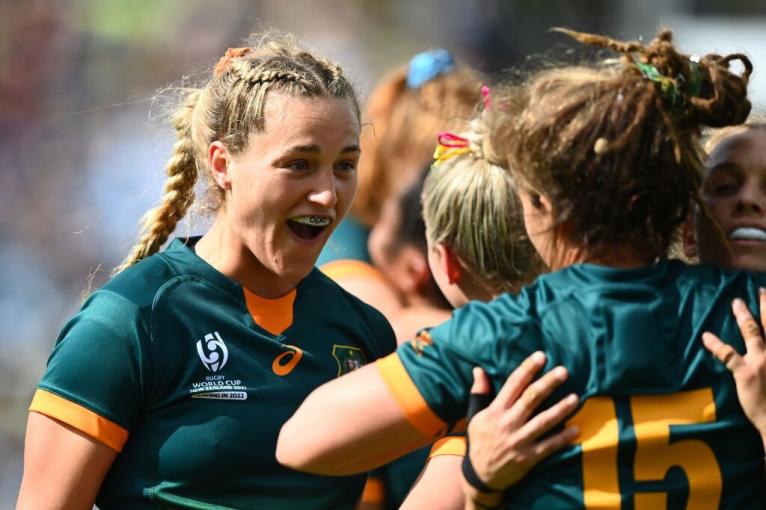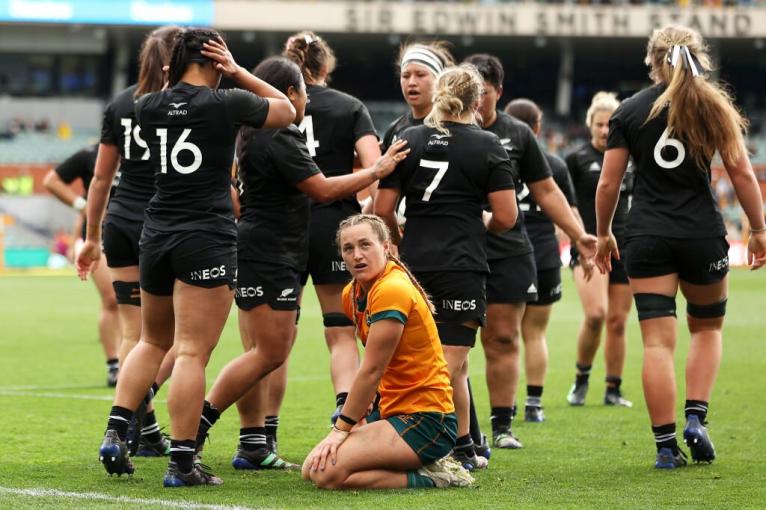You might be familiar with the tale of how Arabella McKenzie ended up in the famous quarters of Harlequins. How, following an initial approach from an Allianz Premier 15s rival, she took the initiative and made direct contact with the club on social media.
Reasoning that Quins would be a better fit for her stylistically, McKenzie slid into the jester’s DMs. Although the club endured a disappointing season, missing out on the play-offs for the first time, it is a move which has paid off for the Australian playmaker.
Only two players scored more than her 97 points during the regular season. Fair dinkum at the best of times, but especially impressive when you consider she had to adjust to a new country, a more set-piece-oriented playing style and was often asked to run out in a position, inside centre, which was previously alien to her.
What you might not have known, moreover, is she suffered a bout of cold feet – both figuratively and literally – soon after arriving in England. Fresh off a long-haul flight and dressed for the Australian summer, McKenzie and Kaitlan Leaney had been buffeted by a downpour as they were ferried around Quins’ training base on the back of a golf buggy.
To be honest, it was pretty awful… jet-lagged, no sleep, s**t coffee. I was like, ‘what am I doing? Why have I come here?
Coming only weeks after they had helped their country to the quarter-finals of Rugby World Cup 2021 in New Zealand, the cold November rain must have hit the pair like a slap to the face.
“To be honest, it was pretty awful… jet-lagged, no sleep, s**t coffee,” McKenzie tells RugbyPass+, before apologising for swearing, as we chat on a more clement June morning. “I was not expecting it to be that cold. I called my mum that night and was like, ‘What am I doing? Why have I come here?’”
Fortunately for Quins and their new recruit, nothing lasts forever, and McKenzie suggests she merely needed an opportunity to let off some steam. “That was just me being dramatic,” she says now.
Certainly, McKenzie acclimatised quickly to her new surroundings – although she still believes British food is bland – and by her own estimation, the player returning to Australia this month is different to the one who pitched up in Guildford seven months ago.
That is not only because she has played with a new number on the back of her jersey. “I’m not used to splitting into forwards and backs so much!” McKenzie says, lamenting that her housemates and compatriots Leaney and Emily Chancellor were in the former category. “But it’s been exciting to learn a new style as well.

“I came over as a fly-half, I’m leaving as an inside centre but it’s good to have a full season in a different position to show that I can cover three positions in the backline; 10, 12, 15. It’s been nice learning a new position.”
McKenzie has handled the adjustment with aplomb, dusting off her “big-girl shoulders” and reacquainting herself with the art of tackling. “It’s been awesome. I’ve never really had to defend in the front line before,” the Wallaroos playmaker says.
“It has been nice to see that I can still tackle. I mean, at the World Cup I probably made two tackles the whole tournament. I think against Gloucester [at Kingsholm last month], I made over 20.”
The 24-year-old credits the players she has played closest to, Lagi Tuima and Emily Scott, with helping to make that switch so seamless.
“Playing inside Lagi and outside Scotty has been really good. Lagi’s such an unreal player and we’ve got such a good connection and a strong bond off the field, and I think it shows on the field. We don’t talk too much but I always know what she’s doing, and she always seems to know what I’m doing.”
I loved tackling as a kid. As soon as I put the 10 jersey on, everyone says I forget how to tackle and hit the breakdown.
Pulling on the number 12 jersey, and assuming the defensive responsibilities that come with it, have also enabled McKenzie to reconnect with an aspect of the game she excelled at as a young, aspiring rugby league player back in northern New South Wales.
“I loved tackling as a kid. As soon as I put the 10 jersey on, everyone says I forget how to tackle and hit the breakdown. Lucy Packer wasn’t very impressed with my breakdown work [against DMP Sharks]!
“But, I guess, it’s been nice to find that aggression and physical side of my game that I haven’t had to use in the past.”
It was during her formative years, growing up among the opal mines of Lightning Ridge, that McKenzie first set herself the goal of becoming the best rugby player in the world. In those days it was a league dream she was chasing, and although Australia’s success at the Rio 2016 Olympic Games turned her head, that competitive spirit has remained undimmed.
That is what drove her to success with the Waratahs, Wallaroos recognition and convinced her to travel in search of new opportunities, first to New Zealand’s South Island with Super Rugby Aupiki side Matat? and then on to Guildford and Quins.

It can also be seen in the decision she made a couple of months ago to supplement her rugby commitments by going to work for a homecare provider in Surrey. Despite the strides made in the women’s game in recent years, for those without an international contract it remains semi-professional at best – the 2022-23 Premier 15s salary cap was £120,000 per squad – and McKenzie is open about her reasons for seeking out a second job.
“We don’t start training till 2pm, so I was kind of just bored sitting around at home,” she admits. “I work for a company that does home care for the elderly, which is really nice and a bit different to what I was doing back in Australia, working in disability and community access things.
“It’s really rewarding in that sense as well and fills my days with a bit more purpose, which is good. [It gives me] a bit of extra cash, because we’re not professional yet. Almost everyone strives for that for the women’s game, but I understand it’s a business and it’s not the same as the men’s yet.
“And it’s another outlet from rugby. You can put all your eggs in one basket, you kind of get a bit stuck in the same mundane day.”
It’s the best comp in the world for 15s. The amount of games you play is invaluable, no amount of money can pay for that.
That extra cash will have come in handy, not only to buy extra jars of vegemite for herself, Leaney and Chancellor or for her favourite Gail’s order – a chocolate and almond croissant and oat flat white, if you’re wondering – but to fill up the coffers having ventured beyond Surrey earlier this year.
During the Women’s Six Nations, McKenzie took advantage of the break in Premier 15s action to explore the UK and Ireland. “Paddy’s Day in Ireland was pretty fun,” she offers cautiously about a trip she took with Leaney and Emma Swords, “a pretty quiet weekend.”
That jaunt is one of many happy memories McKenzie has made since she and Leaney landed in England. From running out at the Stoop for the first time and scoring a try and conversion to help her new side beat arch rivals Saracens, to the “unreal” feeling of lining up at Twickenham.
McKenzie has also made lifelong friendships, and is thankful to Jade Konkel-Roberts, Sarah Bonar, Amy Cokayne and others for the help and support they gave her and her compatriots during their time in Guildford. It’s fair to assume the Australian no longer questions – even flippantly – the decision she made to swap Super W for the Premier 15s.
“It’s the best comp in the world for 15s. The amount of games you play is invaluable, no amount of money can pay for that,” she says. “Eighteen rounds and training and playing together so many times makes your team so much stronger.
“I can see why the England team is so strong because of the amount of rugby they play throughout the year. They play triple the amount of semi-professional/professional [rugby] we would in Australia.”
There is obviously disappointment she wasn’t able to help guide Quins back into the play-offs – especially as she maintains the club possesses the best backline in the league – but McKenzie believes “key injuries to key players” impeded their post-season chances. Who knows, though, maybe she will return for another crack at the title.
“I love Quins,” McKenzie says. “Great organisation, such a great team to be part of.”
Whatever the future has in store for McKenzie, her immediate focus is on forcing her way back into the Wallaroos team for their upcoming World Rugby Pacific Four Series and O’Reilly Cup commitments.
McKenzie has been in contact with the team’s coaching staff over recent weeks but admits she “had a bit of FOMO” having woken in the early hours to watch their win against Fiji last month. “It was the first camp and Test that I’d missed since 2019.”

In her absence, former New Zealand Barbarians fly-half Carys Dallinger was handed the green and gold 10 jersey having impressed in her short spell with the Reds. It is competition McKenzie welcomes.
“It’s unreal to have another 10 in the squad,” she insists. “We went to the World Cup having me as the only 10 and full-backs as the other options. So, it’s only going to make the team better and make each other better as well. It’s really important for the Wallaroos to have multiple options and depth in every position.”
Something McKenzie is perhaps less sure about is which level of WXV is the best for Australia to participate in when the inaugural campaign of World Rugby’s new women’s Test competition gets under way this October.
The competitor inside her – the woman whose drive has taken her around the world – is unequivocal that WXV 1, via the Pacific Four Series top three, is the objective. However, there is also a concession that winning matches in the level below could be an attractive option.
Australia were beaten by champions the Black Ferns, Canada and the USA in New Zealand last year to finish bottom of the Pacific Four standings. A repeat performance over the next month would consign the Wallaroos to WXV 2 and matches against South Africa, Scotland, Japan, Samoa and either Italy or Spain in Cape Town in four months’ time.
“We’re confident that we can make WXV 1, that’s the goal and you want to be playing the best teams in the world,” McKenzie says.
“[But] it’s a tricky one. We were talking about this the other day, probably the Wallaroos are at that WXV 2 level just because we haven’t been as professional as France, England and Wales.
“So, I think as a whole we’d probably be better off versing the teams in WXV 2, but it will just depend on how we go at Pac Four and what performances we put in will really determine where we end up and things like that. But on any day, I’d say the Wallaroos are a strong team.”
As New Zealand, Canada and the USA could be about to find out, the Wallaroos will be an even stronger outfit for the lessons McKenzie has learned during her season in England.



Comments
Join free and tell us what you really think!
Sign up for free